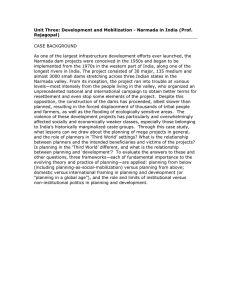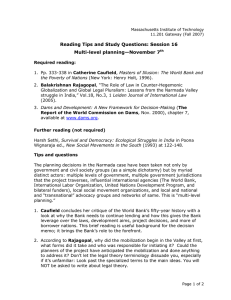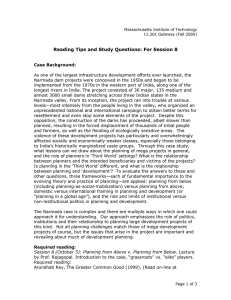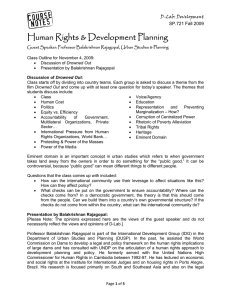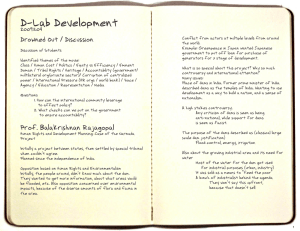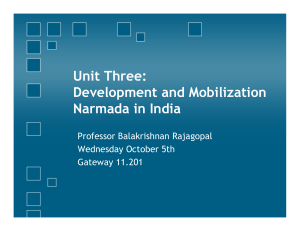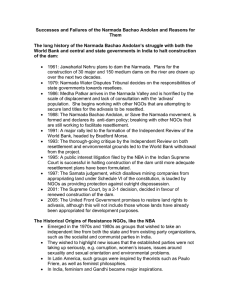Reading Tips and Study Questions: Session 15 Planning from “above” versus
advertisement
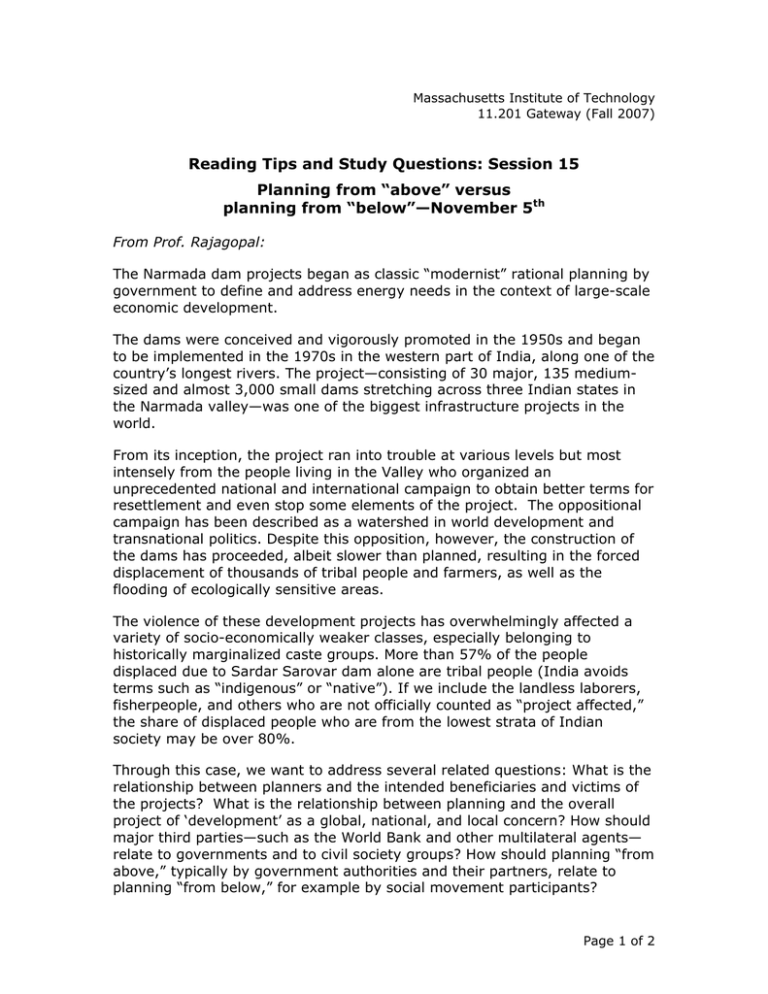
Massachusetts Institute of Technology 11.201 Gateway (Fall 2007) Reading Tips and Study Questions: Session 15 Planning from “above” versus planning from “below”—November 5th From Prof. Rajagopal: The Narmada dam projects began as classic “modernist” rational planning by government to define and address energy needs in the context of large-scale economic development. The dams were conceived and vigorously promoted in the 1950s and began to be implemented in the 1970s in the western part of India, along one of the country’s longest rivers. The project—consisting of 30 major, 135 mediumsized and almost 3,000 small dams stretching across three Indian states in the Narmada valley—was one of the biggest infrastructure projects in the world. From its inception, the project ran into trouble at various levels but most intensely from the people living in the Valley who organized an unprecedented national and international campaign to obtain better terms for resettlement and even stop some elements of the project. The oppositional campaign has been described as a watershed in world development and transnational politics. Despite this opposition, however, the construction of the dams has proceeded, albeit slower than planned, resulting in the forced displacement of thousands of tribal people and farmers, as well as the flooding of ecologically sensitive areas. The violence of these development projects has overwhelmingly affected a variety of socio-economically weaker classes, especially belonging to historically marginalized caste groups. More than 57% of the people displaced due to Sardar Sarovar dam alone are tribal people (India avoids terms such as “indigenous” or “native”). If we include the landless laborers, fisherpeople, and others who are not officially counted as “project affected,” the share of displaced people who are from the lowest strata of Indian society may be over 80%. Through this case, we want to address several related questions: What is the relationship between planners and the intended beneficiaries and victims of the projects? What is the relationship between planning and the overall project of ‘development’ as a global, national, and local concern? How should major third parties—such as the World Bank and other multilateral agents— relate to governments and to civil society groups? How should planning “from above,” typically by government authorities and their partners, relate to planning “from below,” for example by social movement participants? Page 1 of 2 Required reading for November 5th: 1. READ Arturo Escobar, “Planning,” in The Development Dictionary, W. Sachs (ed.), London: Zed Books (1992). 2. READ Sanjeev Khagram, Dams and development: Transnational Struggles for Water and Power (2005), chapter 3. 3. READ Balakrishnan Rajagopal, “The Violence of Development,” Washington Post, August 8, 2001 (op-ed). 4. SKIM Arundhati Roy, The Greater Common Good (1999). Free on-line at http://www.flonnet.com/fl1611/16110040.htm Recommend reading 5. Chapter 2, Amartya Sen, Development as Freedom (New York: Random House, 1999). Tips and questions a. As we’ve seen again and again in the course, since “planning” is defined in many ways by both its critics and its fans, it’s important to pay close attention to how a particular argument about planning defines the term and why. How and why does Escobar make a case for a “postdevelopment” perspective on social change in developing countries? And why exactly does he want “planning”—at least in the limited, modernist rational sense of the term, if not the more adaptive and broad sense we have been exploring—to “fade away from concern”? b. Based on the required readings, including Roy’s sharp critique and Khagram’s as well, how should societies define “development” and “planning”? In light of Rajagopal’s arguments, how should the Narmada dam projects’ disparate and severe impacts on particular groups be weighed in those definitions of progress and the legitimate mechanisms for producing it? Note: We will screen “Drowned Out,” a powerful documentary film about Narmada, this week, and we also plan to stream it to the course video webpage. Page 2 of 2
